It looks like you're using an Ad Blocker.
Please white-list or disable AboveTopSecret.com in your ad-blocking tool.
Thank you.
Some features of ATS will be disabled while you continue to use an ad-blocker.
8
share:
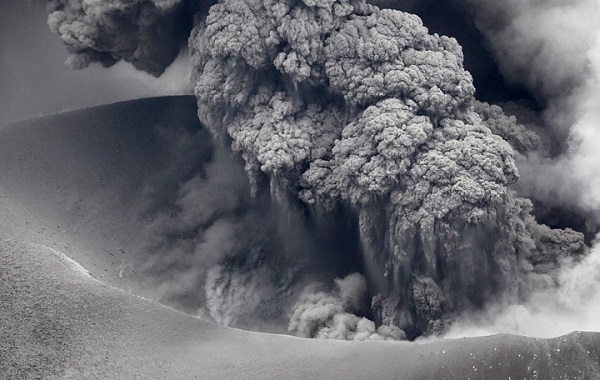
I often asked my fellow acquaintances: is possible to take such natural phenomenon as the volcanic activity of the Earth under control? As a rule ,the question caused bewilderment with the answer "no" and when I said that it is possible, I received an inappropriate gesture.
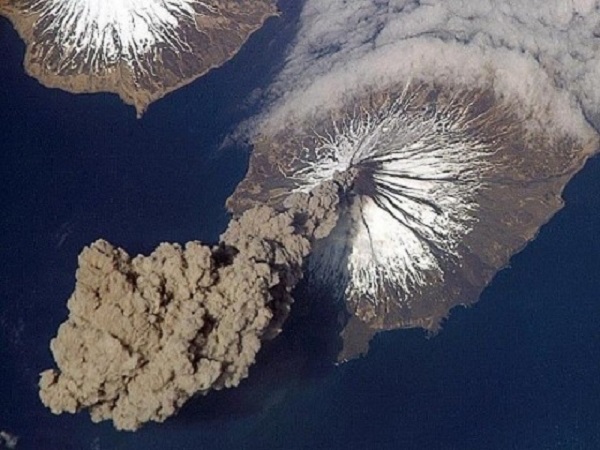
On the Earth's surface there are 4 types of volcanoes, they are different from each other in their lava descent speed after eruption.
High speed - when the lava leaves through the central opening of a volcano, leaving a hole. Such volcanoes on Earth are about 4-5 in number. They are called : " The gate to hell".
Averege speed - when the lava stays for some time in the a muzzle of a volcano and during this time, cooling, it manages to create a crater and stiffen on a depth of 30-50 meters ,then the lava goes down, leaving an opening. At the same time in the muzzle of the volcano a "cork" is formed.
Slow speed- when the "cork" with it’s length exceeds the volcano radius in the lower part of the "cork" in the horizontal plane.
Very Slow speed - when length of "cork" exceeds height of the volcanic muzzle.
How will the lava in each of these four cases behave?
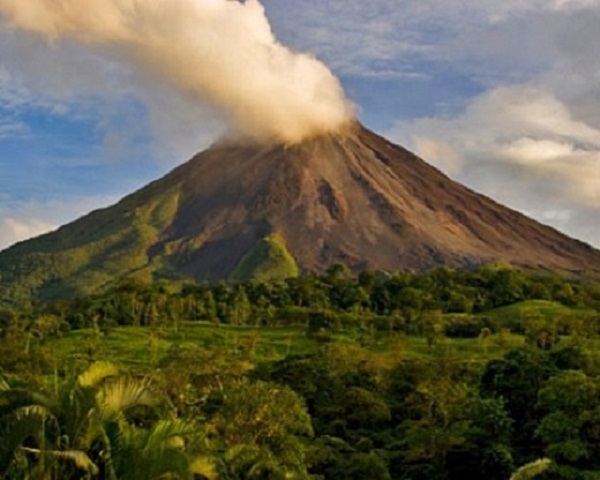
In the first case - the lava will quietly rise to edge of the muzzle of the volcano, without creating any pressure or any emissions and having reached edge of a muzzle of a volcano, it will quietly begin to leak from the lowest part of the edge of the volcano muzzle.
In the second case - at repeated eruption the rising lava will create all increasing pressure inside of the volcano canal. At the same time the volcano canals sidewalls will begin to crumble and shower down as a result of the high pressure and high temperature, creating the convection movement together with internal gases.
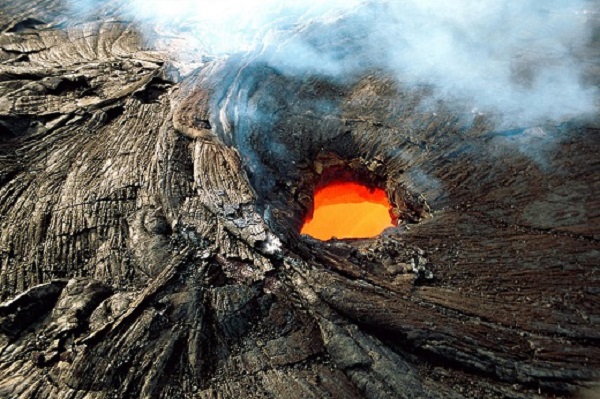
The longer the process will take place, the dispersion (size) of particles of the formed dust will be higher. At high dispersion during the explosion of a volcano dust will be thrown out to a high altitude into the sky and dust will pollute large areas.
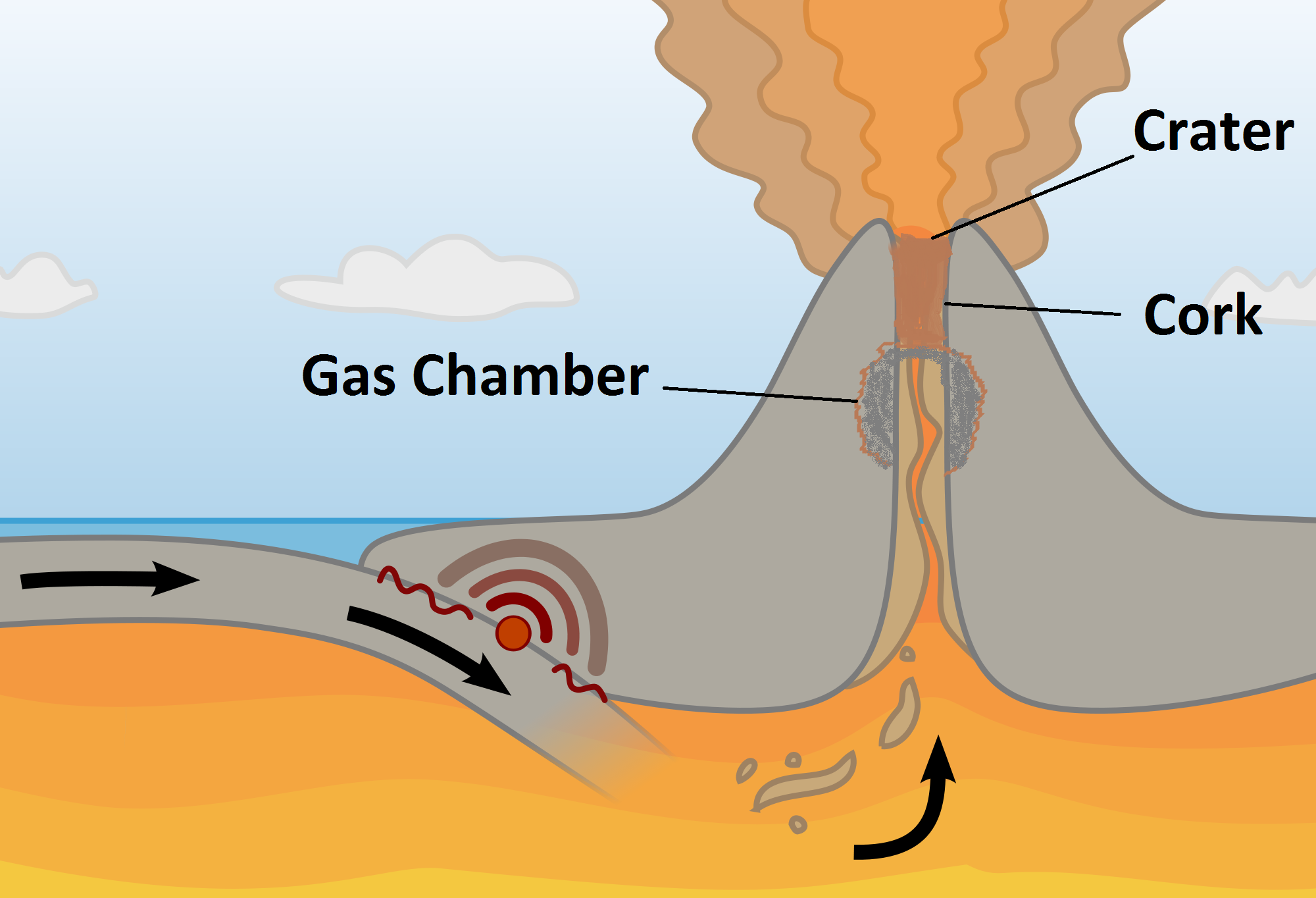
At a rather short process of dust formation inside the volcanoes cavity, at low dispersion of particles of dust and at an explosion of a volcano, the pyroclastic stream will roll down from its top down, with a speed depending on the volcanoes height.
This speed can reach 250 km/hour.
Such a stream in the past burned and destroyed the city of Pompeii.
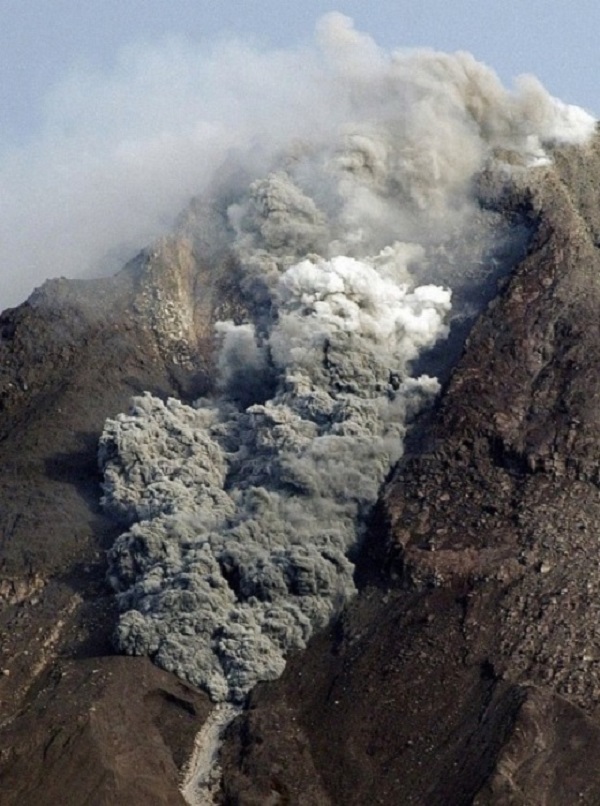
In the third case - the eruption will not begin at the volcano top but from the sides of the volcano cone. In the case of a long convection process inside the volcano, it’s internal walls can diminish to such an extent that the top of the volcano cone can collapse inside itself, having formed a caldera (a huge crater) or it could move sideways and roll down from the mountain. At the same time if it fall into water, then there is a possibility that a tsunami will form.
A similar process happened with the “Etna” Volcano on Sicily recently.
In the fourth case - the volcano is considered extinct and in the case of renewal of volcanic activity in this area, a new volcano can appear in the foothold of the old volcano.
What can we do in the first three cases?
A conclusion arises:
lead the second and third dangerous cases to the first safe one.
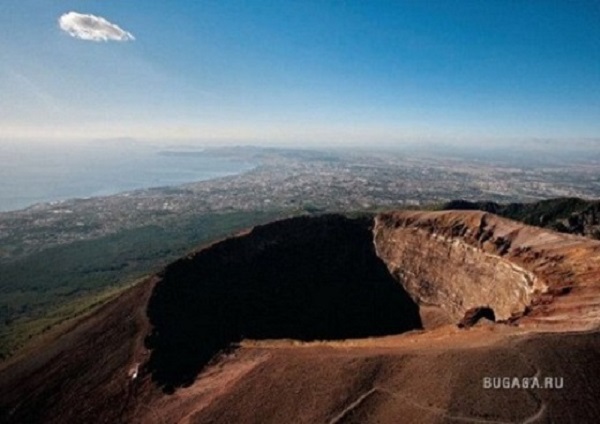
In the second case - with help from aircraft and bunker busters , you destroy the volcano "cork" inside the crater of the volcano and lower the edge of the volcano in the place necessary to safely discharge the lava at the next eruption.
In the third case - it is necessary to make an opening in the crater,in the depth of the "cork" in any available way (a boring machine, a self-propelled pile driver, etc.). After that - expand the received opening by means of small internal explosions.
To sum it all up:
If we use this method to “unseal” volcanoes when they are dormant, then the threat of earthquakes will decrease since at the increase of pressure ,magma will begin "to breathe" through the openings in the volcanoes but it will not move the tectonic plates of the earth’s crust.
You can compare the volcano with a daily life example of boiling milk in a pot:
When the pot is closed with a lid then when the milk will boil you will not be able to control the pressure that is building up and the milk will burst through the lid and and milk will escape the pot.
But if you take the lid off the pressure that is building up will be controlled.
For example the Kilauea volcano in Hawaii which is an open volcano and the lava pours from it without creating an explosion (the result we want to achieve)-
I am aware that bombing with "bunker busters" is not the most popular idea as you can read in this blog post -
Link
And in a response I received from a member of the Alaska Volcano Observatory regarding the first case -
Well, the explosion would have to be big enough to go about 5 miles deep, in order to get at the roots of a volcano - and I don't think we have that capability. Even if we did - there's a complex arrangement between pressure and permeability that permits some volcanoes to erupt explosively. The risk/benefit calculation doesn’t pan out.
But the what the idea still remains untested as all of these other attempts were to divert flowing lava or bomb the volcano while it was actively erupting .
At first I propose to try the second case before attempting the first one.
I would be glad to hear your thoughts on the subject.
Thank you for reading.
edit on 14-3-2017 by OlegK because: Youtube video
a reply to: Discotech
Wow, why does it do that? I would of expected something like the end of Terminator 2, where the molteness just pulls you down to die. Although I don't think anyone would survive but a mere few seconds after falling in.
Seeing that, perhaps not the best idea to drop a bomb?
What about a kinetic satellite weapon?? Would that go deep enough to penetrate the cork??
Wow, why does it do that? I would of expected something like the end of Terminator 2, where the molteness just pulls you down to die. Although I don't think anyone would survive but a mere few seconds after falling in.
Seeing that, perhaps not the best idea to drop a bomb?
What about a kinetic satellite weapon?? Would that go deep enough to penetrate the cork??
a reply to: OlegK
Excellent question and one that many people think on a lot these day's with the supervolcano caldera of yellowstone park slowly swelling and getting ready to pop it's lid at some point in the future.
I CAN imagine an unprecedented feat of engineering creating vast subterranean chambers to relieve the pressure, the problem is how do you create a valve to regulate the flow of pressure when you are dealing with molten rock at those temperatures, how do you relieve just enough pressure so as to not cause a collapse and so as to not cause an explosive release of pressure, in the worst best scenario a controlled eruption would be the final protective measure, cause a premature eruption now in order to stave off a far more massive eruption in the future.
The problem is that even freezing these molten rock plume's using pumped in coolant would only create even more catastrophe as the pressure below would then crack the super cooled wall's of it's own natural upward route and form a new route to the surface with the encumbant earth quake's and massive earth displacement's this would be accompanied by.
Smaller NORMAL volcano's however may be potentially contolled by using super cooling of there plume's but it would have to be done at depth, unlike super volcano's which are based on top of super thermal plume's originating far below the mantel the Normal volcanos are usually the result of plate techtonic generated heat and melting actions creating magma chamber's beneath the crust which then force there way up and out of the earth in a natural pressure release action, super cooling them could also have an adverse effect on the local techtonic's and this in turn could lead to other method's of release including massive earth quake's far beyond the scope of the natural tremor's that would have accompanied the natural release of energy by the volcanic eruption.
But theoretically a volcano could be harness and perhaps it's eruption's controlled, a supervolcano though is another matter and the engineering needed to even create a pressure release mechanism of the necessary scale is perhaps beyond the scope of human engineering in both scale and technological capability at this time.
Still there are those that are seeking a method to do so?.
www.geo.mtu.edu...
Excellent question and one that many people think on a lot these day's with the supervolcano caldera of yellowstone park slowly swelling and getting ready to pop it's lid at some point in the future.
I CAN imagine an unprecedented feat of engineering creating vast subterranean chambers to relieve the pressure, the problem is how do you create a valve to regulate the flow of pressure when you are dealing with molten rock at those temperatures, how do you relieve just enough pressure so as to not cause a collapse and so as to not cause an explosive release of pressure, in the worst best scenario a controlled eruption would be the final protective measure, cause a premature eruption now in order to stave off a far more massive eruption in the future.
The problem is that even freezing these molten rock plume's using pumped in coolant would only create even more catastrophe as the pressure below would then crack the super cooled wall's of it's own natural upward route and form a new route to the surface with the encumbant earth quake's and massive earth displacement's this would be accompanied by.
Smaller NORMAL volcano's however may be potentially contolled by using super cooling of there plume's but it would have to be done at depth, unlike super volcano's which are based on top of super thermal plume's originating far below the mantel the Normal volcanos are usually the result of plate techtonic generated heat and melting actions creating magma chamber's beneath the crust which then force there way up and out of the earth in a natural pressure release action, super cooling them could also have an adverse effect on the local techtonic's and this in turn could lead to other method's of release including massive earth quake's far beyond the scope of the natural tremor's that would have accompanied the natural release of energy by the volcanic eruption.
But theoretically a volcano could be harness and perhaps it's eruption's controlled, a supervolcano though is another matter and the engineering needed to even create a pressure release mechanism of the necessary scale is perhaps beyond the scope of human engineering in both scale and technological capability at this time.
Still there are those that are seeking a method to do so?.
www.geo.mtu.edu...
edit on 14-3-2017 by LABTECH767 because: (no reason given)
a reply to: worldstarcountry
It seems though no matter what you throw into a volcano, it pisses it off
Here's a jerry can of water being thrown into a peaceful volcano
a reply to: OlegK
But surely bombing it will make it no longer dormant, it doesn't take much to piss off a volcano
It seems though no matter what you throw into a volcano, it pisses it off
Here's a jerry can of water being thrown into a peaceful volcano
a reply to: OlegK
But surely bombing it will make it no longer dormant, it doesn't take much to piss off a volcano
a reply to: LABTECH767
Hey
Thank you for the long reply, great info !
I do belive that there should be more talk and especially doing about this theory due the the massive benefit it could bring if succesfully tested.
I really hope that this will happen.
For now these volcanoes are a ticking
**Note - I sent an email to the writer of what you sent me to see if there was any progress .
I will update if I get an anwser.
Hey
Thank you for the long reply, great info !
I do belive that there should be more talk and especially doing about this theory due the the massive benefit it could bring if succesfully tested.
I really hope that this will happen.
For now these volcanoes are a ticking
edit on 15-3-2017 by OlegK because: (no reason given)
**Note - I sent an email to the writer of what you sent me to see if there was any progress .
I will update if I get an anwser.
edit on 15-3-2017 by OlegK because: (no reason given)
So perhaps the lava is reacting to water?? The organic content from the trash bag and the water jug may have just initiated the violent eruptions due
to the same thing when you have a pan of hot oil heating up with moisture??? It splatters everywhere. Perhaps its the same principal, and that maybe
inorganic compounds like metal and rock would not have a similar effect?? Ever notice how cool the glow of hot lava is?? It always looks s nice even
in video and photos, almost mesmerizing.
a reply to: OlegK
I was thinking of maybe drilling a 'carburetor' vent that allows the volcano to breathe?
But then, an eruption only begets so much toxic particles into the atmosphere, at once?
So if we put a carburetor vent in, those toxins would just keep spewing kinda like the daughters
of fukushima? Elements vs. radio-nucleides? (sp?)
I don't think mother nature likes to be molested, so we should probably restrain ourself and work for good karma.
I was thinking of maybe drilling a 'carburetor' vent that allows the volcano to breathe?
But then, an eruption only begets so much toxic particles into the atmosphere, at once?
So if we put a carburetor vent in, those toxins would just keep spewing kinda like the daughters
of fukushima? Elements vs. radio-nucleides? (sp?)
I don't think mother nature likes to be molested, so we should probably restrain ourself and work for good karma.
It's just a matter of time until Yellowstone and the Jemez Caldera blow again. Global 3 year winter from the ash clouds.
Could be an extinction event. There's also a negative side....
Could be an extinction event. There's also a negative side....
edit on 15-3-2017 by olaru12 because: (no reason given)
originally posted by: Discotech
a reply to: OlegK
This is what happens when you throw a bag of trash into a volcano
I don't think dropping bombs on a volcano will subdue its ferociousness but will instead piss it off and make it erupt very violently
Now that's how to get rid of a body...
On topic...seems like I read somewhere a while back about a hydrogen bomb being a possible temporary stop....or maybe that was Scientology...anywho...
originally posted by: Vasa Croe
originally posted by: Discotech
a reply to: OlegK
This is what happens when you throw a bag of trash into a volcano
I don't think dropping bombs on a volcano will subdue its ferociousness but will instead piss it off and make it erupt very violently
Now that's how to get rid of a body...
Sure is
edit on 15-3-2017 by OlegK because: (no reason given)
new topics
-
If they can see...they can read!!
Rant: 3 hours ago -
Tesla Cybertruck Explodes in Front of Trump Hotel in Las Vegas
Mainstream News: 8 hours ago -
Maybe they didn't get away with it: The Lincoln-Kennedy assassination parallels. 7 sentences long.
History: 11 hours ago
top topics
-
Tesla Cybertruck Explodes in Front of Trump Hotel in Las Vegas
Mainstream News: 8 hours ago, 19 flags -
Ukraine halts transit of Russian gas to Europe after a prewar deal expired
Political Conspiracies: 15 hours ago, 12 flags -
Welp...Happy New Year!!
General Chit Chat: 17 hours ago, 8 flags -
If they can see...they can read!!
Rant: 3 hours ago, 5 flags -
Maybe they didn't get away with it: The Lincoln-Kennedy assassination parallels. 7 sentences long.
History: 11 hours ago, 4 flags
active topics
-
Can someone 'splain me like I'm 5. Blockchain?
Science & Technology • 99 • : IndieA -
Tesla Cybertruck Explodes in Front of Trump Hotel in Las Vegas
Mainstream News • 51 • : cherokeetroy -
Vehicle Strikes people in New Orleans
Mainstream News • 241 • : BeyondKnowledge3 -
Get Ready - Here comes the Bird Flu Pandemic - Millions are Notified
Diseases and Pandemics • 65 • : annonentity -
SCOTUS Chief Justice JOHN ROBERTS Ends 2024 Describing His Fears for Safety of U.S. Judges.
Above Politics • 10 • : WeMustCare -
Maybe they didn't get away with it: The Lincoln-Kennedy assassination parallels. 7 sentences long.
History • 9 • : BernnieJGato -
If they can see...they can read!!
Rant • 5 • : Myhandle -
US disburses $3.4 billion in budget aid for Ukraine, Yellen says
US Political Madness • 25 • : VariedcodeSole -
I dont understand what i just witnessed
Social Issues and Civil Unrest • 28 • : Daughter2v2 -
Remember These Attacks When President Trump 2.0 Retribution-Justice Commences.
2024 Elections • 118 • : WeMustCare
8
